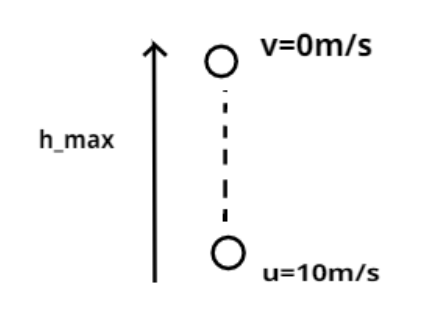
A body is projected vertically upwards with a velocity of 10m/s. The maximum height reached by the body is :
$
(a){\text{ 5m}} \\
(b){\text{ 2m}} \\
(c){\text{ 1m}} \\
(d){\text{ 100m}} \\
$
Answer
122.4k+ views
Hint: In this question use the equation of the third law of the motion that is ${v^2} = {u^2} + 2as$, since at the maximum height the final velocity of the body will be zero therefore use this concept to find the maximum height attained by the body.
Complete step-by-step solution -

According to third law of motion we have,
${v^2} = {u^2} + 2as$.............. (1)
Where, v = final velocity of the particle, u = initial velocity of the particle, a = acceleration of the particle and s = distance travelled by the particle.
Now it is given that a body is projected vertically upwards with a velocity of 10m/s.
So the initial velocity of the body is, u = 10m/s
After reaching the maximum height final velocity of the body becomes zero and at this point acceleration due to gravity is maximum and working downwards so a = -g = -10 m/s2.
So s becomes ${H_{\max }}$
Now substitute the value in equation (1) we have,
$ \Rightarrow 0 = {\left( {10} \right)^2} + 2\left( { - g} \right){H_{\max }}$
$ \Rightarrow 2g{H_{\max }} = 100$
$ \Rightarrow {H_{\max }} = \dfrac{{100}}{{2 \times 10}} = 5$m.
So the maximum height reached by the body when it is thrown vertically upwards with a velocity of 10m/s is 5 m.
So this is the required answer.
Hence option (A) is the correct answer.
Note – The trick point here was that the acceleration due to gravity is taken as negative as positive upwards that is y direction is considered as positive however g will be acting in downwards or negative y direction thus it is taken as negative. The equation of motion is valid if and only if the acceleration remains constant all throughout the journey of the body and since it was constant as g and thus the laws of motions are applicable. The equation of motion other than ${v^2} - {u^2} = 2as$ are $v = u + at{\text{ and s = ut + }}\dfrac{1}{2}a{t^2}$.
Complete step-by-step solution -

According to third law of motion we have,
${v^2} = {u^2} + 2as$.............. (1)
Where, v = final velocity of the particle, u = initial velocity of the particle, a = acceleration of the particle and s = distance travelled by the particle.
Now it is given that a body is projected vertically upwards with a velocity of 10m/s.
So the initial velocity of the body is, u = 10m/s
After reaching the maximum height final velocity of the body becomes zero and at this point acceleration due to gravity is maximum and working downwards so a = -g = -10 m/s2.
So s becomes ${H_{\max }}$
Now substitute the value in equation (1) we have,
$ \Rightarrow 0 = {\left( {10} \right)^2} + 2\left( { - g} \right){H_{\max }}$
$ \Rightarrow 2g{H_{\max }} = 100$
$ \Rightarrow {H_{\max }} = \dfrac{{100}}{{2 \times 10}} = 5$m.
So the maximum height reached by the body when it is thrown vertically upwards with a velocity of 10m/s is 5 m.
So this is the required answer.
Hence option (A) is the correct answer.
Note – The trick point here was that the acceleration due to gravity is taken as negative as positive upwards that is y direction is considered as positive however g will be acting in downwards or negative y direction thus it is taken as negative. The equation of motion is valid if and only if the acceleration remains constant all throughout the journey of the body and since it was constant as g and thus the laws of motions are applicable. The equation of motion other than ${v^2} - {u^2} = 2as$ are $v = u + at{\text{ and s = ut + }}\dfrac{1}{2}a{t^2}$.
Recently Updated Pages
The ratio of the diameters of two metallic rods of class 11 physics JEE_Main

What is the difference between Conduction and conv class 11 physics JEE_Main

Mark the correct statements about the friction between class 11 physics JEE_Main

Find the acceleration of the wedge towards the right class 11 physics JEE_Main

A standing wave is formed by the superposition of two class 11 physics JEE_Main

Derive an expression for work done by the gas in an class 11 physics JEE_Main

Trending doubts
JEE Main 2025 Session 2: Application Form (Out), Exam Dates (Released), Eligibility & More

JEE Main Login 2045: Step-by-Step Instructions and Details

Class 11 JEE Main Physics Mock Test 2025

JEE Main Chemistry Question Paper with Answer Keys and Solutions

JEE Main Exam Marking Scheme: Detailed Breakdown of Marks and Negative Marking

JEE Main 2023 January 24 Shift 2 Question Paper with Answer Keys & Solutions

Other Pages
JEE Advanced Marks vs Ranks 2025: Understanding Category-wise Qualifying Marks and Previous Year Cut-offs

NCERT Solutions for Class 11 Physics Chapter 1 Units and Measurements

NCERT Solutions for Class 11 Physics Chapter 9 Mechanical Properties of Fluids

Units and Measurements Class 11 Notes: CBSE Physics Chapter 1

JEE Advanced 2025: Dates, Registration, Syllabus, Eligibility Criteria and More

NCERT Solutions for Class 11 Physics Chapter 2 Motion In A Straight Line




